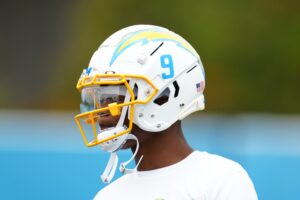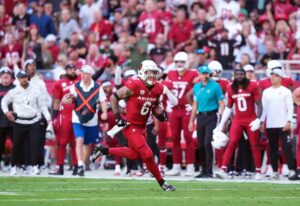When Tony Romo went down with (another) broken collarbone in the 2016 preseason, Cowboys’ fans went into panic mode. Enter from stage right, Dak Prescott, a fourth-round rookie from Mississippi State.
Prescott surprised coaches, teammates, fans, and fantasy owners alike with his play as a fill-in for Romo until he healed up. Prescott played well, very well, well enough that when Romo was medically cleared to return, he didn’t. In what became permanent relief of Romo, Prescott completed 67.8 percent of his passes on his way to 3,667 yards. He threw 23 touchdowns to only four interceptions.
Dak Prescott and the Sophomore Slump
Combined with the impressive year-one performance of rookie running back Ezekiel Elliott, Cowboys fans were rejoicing at their draft stock. Both rookies thrived behind one of the best offensive lines in the NFL.
In his second season, Prescott struggled mightily at times and aptly defined the term “regression.” Despite throwing more attempts in 2017, he had fewer completions, completion percentage, yards, and touchdowns than his 2016 outing. In fact, the only statistical number that went up in his second season was the number of interceptions he threw with 13. Dak finished his second season with 3,324 yards and 22 touchdowns.
All told, Prescott had eight games with less than 200 yards passing. In five games, Prescott threw multiple interceptions. We also saw the effect that a rough season played for the receiver group. In seasons where Dez Bryant has played all 16 games, he’s been over 1,200 yards and in double-digit touchdowns. In 2017 Bryant played all 16 games and finished with 838 yards and six touchdowns. Cole Beasley also finished with a down season, posting his lowest yards-per-game average since the 2013 season.
Dak went from being a smart, exciting, dual-threat rookie to a middling quarterback in the span of one season. What changed? While it’s impossible to discount the absence of playmakers like Elliott, the Cowboys had sufficient personnel to keep the run game relevant. Missing Tyron Smith for a few games was also a huge factor in terms of protection. In week nine against Atlanta, with Smith out Prescott absorbed nine sacks.
One of the biggest possible factors may be laid squarely at the feet of Jason Garrett. Basing the offensive play-calling strictly on personnel and not more on scheme may be a big factor in this year’s struggles for Prescott and company. Garrett needs to address the playbook and build a better scheme that fits the talent the Cowboys have to see the most return from his young stars.
Fantasy Impact
Owners who drafted Prescott early suffered for much of the season. Prescott eclipsed 250 passing yards only three times all season. His rushing yardage and touchdowns were his saving grace for fantasy purposes and kept his floor fairly safe. However, it wasn’t just Prescott owners that suffered from a poor season. Owners of Bryant, Beasley, and Jason Witten also felt the fantasy sting.
Looking forward to next season, Prescott will be someone to keep an eye on. He could end up being a solid bargain pick, especially in two-quarterback leagues or leagues that utilize a super-flex position.






